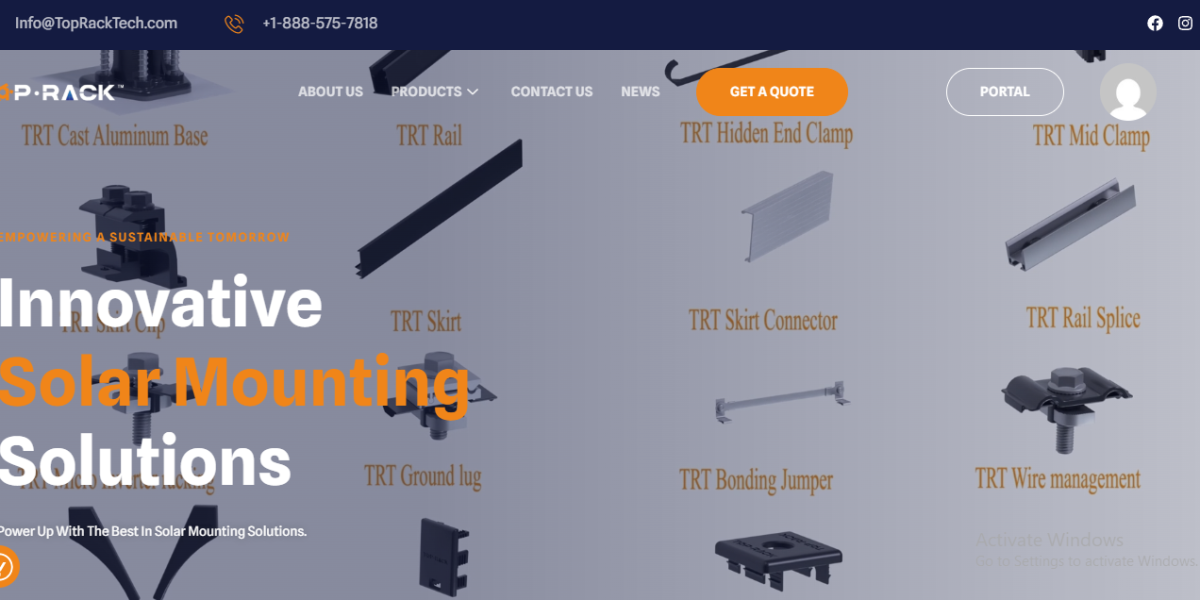As solar energy continues to gain momentum in the renewable energy sector, installation methods are evolving to meet diverse architectural, environmental, and economic needs. One such method that has grown in popularity—especially for flat rooftops and certain ground installations—is ballasted solar mounting. This technique provides a non-invasive, cost-effective, and flexible alternative to traditional solar panel racking systems.
In this article, we will explore what ballasted solar mounting is, how it works, its advantages and disadvantages, and where it is best applied.
What is Ballasted Solar Mounting?
Ballasted solar mounting refers to a type of solar panel racking system that does not require penetration into the surface (such as a rooftop or ground). Instead of using mechanical fasteners like screws or bolts, this system uses ballast—typically concrete blocks or other heavy materials—to hold the solar panels in place.
This method is most commonly used on flat roofs where drilling into the surface might compromise the structure or void warranties. It is also suitable for ground-mounted systems in areas where soil penetration is either not feasible or not permitted due to environmental or regulatory concerns.
How Ballasted Mounting Systems Work
The basic principle behind ballasted mounting is simple: use weight to resist the forces acting on the solar panels, such as wind uplift and seismic activity. Here’s how it works:
-
Mounting Structure: A racking system is placed on the surface. This structure supports the solar panels at the desired tilt angle for maximum energy capture.
-
Ballast Weights: Heavy materials like concrete blocks are placed on or around the racking system to keep it in place. The amount and distribution of ballast are calculated based on engineering assessments that consider local wind loads, seismic activity, and panel tilt.
-
Panel Attachment: Solar panels are then attached to the racking system using clamps or brackets, similar to traditional mounting methods.
Some ballasted systems also incorporate optional anchoring for added security, particularly in high-wind zones.
Types of Ballasted Mounting Systems
There are various configurations of ballasted solar mounting systems to suit different needs:
1. Flat Roof Ballasted Systems
These are designed specifically for commercial and industrial buildings with flat roofs. They can be:
-
East-West oriented for higher energy density.
-
South-facing (or north-facing in the southern hemisphere) for maximum exposure.
2. Ground Ballasted Systems
Used in locations where ground penetration is not viable due to rocky terrain, contamination risks, or preservation zones. These systems can be rapidly deployed and easily removed, making them suitable for temporary installations.
3. Hybrid Systems
These combine ballasting with limited anchoring for enhanced stability. Hybrid systems are useful in areas with moderate wind or seismic concerns, where full ballasting may not be sufficient alone.
Advantages of Ballasted Solar Mounting
Ballasted systems offer a wide range of benefits:
1. Non-Penetrative
The most significant advantage is that they do not require drilling into rooftops or ground surfaces. This preserves the structural integrity of the roof and prevents potential leaks.
2. Quick and Easy Installation
Without the need for complex anchoring, installation times are often shorter, reducing labor costs and speeding up project timelines.
3. Lower Risk to Roof Integrity
Since the system sits on top of the roof membrane, there’s less risk of compromising the waterproofing layer—important for warranty protection.
4. Ideal for Leased or Temporary Sites
Because these systems are non-invasive and relatively easy to remove, they are perfect for locations where permanent installation is not an option.
5. Reusability
Ballasted systems are typically modular and can be relocated or reconfigured with minimal effort.
Disadvantages of Ballasted Solar Mounting
Despite its advantages, ballasted solar mounting is not without limitations:
1. Weight Concerns
Adding ballast can significantly increase the load on a roof. Structural assessments are necessary to ensure the building can support the extra weight.
2. Wind Load Challenges
Ballasted systems may be more vulnerable to high winds, especially if improperly designed. Engineering must account for uplift forces to prevent displacement.
3. Limited Tilt Options
To minimize wind exposure and ballast weight, tilt angles are often limited, which can slightly reduce energy production compared to more optimally tilted systems.
4. Footprint
Ballasted systems may require more spacing between rows to reduce shading, resulting in a lower power density per square foot.
5. Maintenance Accessibility
Depending on the layout, ballast blocks can obstruct access to wiring or drains, making maintenance more challenging.
Applications and Use Cases
Ballasted solar mounting is best suited for:
-
Flat commercial rooftops
-
Low-slope industrial buildings
-
Temporary power installations
-
Brownfields or landfills where ground penetration is restricted
-
Green roofs where preservation of membrane and plant life is crucial
It is less commonly used in residential settings, where pitched roofs are more common and anchoring is typically preferred.
Engineering and Design Considerations
Designing a safe and efficient ballasted system involves more than just placing concrete blocks on a roof. Key considerations include:
-
Structural Load Analysis: Evaluating if the roof or ground can handle the extra weight.
-
Wind Tunnel Testing: Ensuring the design can withstand local wind conditions.
-
Seismic Zones: Adjusting ballast distribution for earthquake resistance.
-
Drainage and Water Flow: Preventing obstruction of rooftop drainage systems.
-
Thermal Expansion: Allowing for movement due to temperature changes.
Modern ballasted systems often use software tools for precision design, optimizing the placement of panels and ballast for maximum efficiency and safety.
Trends and Innovations
With the increasing focus on sustainability and rapid deployment, ballasted mounting systems are evolving:
-
Lightweight Ballast Materials: New materials like aerated concrete or recycled plastics help reduce total system weight.
-
Aerodynamic Designs: Streamlined racking systems reduce wind uplift and require less ballast.
-
Integrated Ballast Solutions: Some systems incorporate ballast into the racking itself, reducing the number of separate components.
Conclusion
Ballasted solar mounting is a versatile and non-invasive method of installing solar panels, especially well-suited for flat roofs and environmentally sensitive sites. It offers a practical solution where traditional anchoring is not viable, providing a balance of flexibility, ease of installation, and system performance.
However, successful implementation depends on careful engineering to manage structural loads, wind resistance, and overall system stability. As technology continues to evolve, ballasted systems are likely to become even more efficient and adaptable, playing a critical role in expanding solar adoption across diverse terrains and structures.












